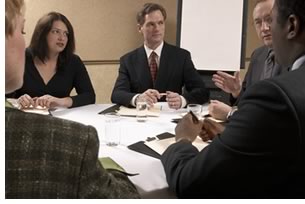

07/2005
Just because I’m paranoid, it doesn’t mean they’re not after me!
by Grant A. Simpson, FAIA, and James B. Atkins, FAIA
When the topic of risk management comes up in discussions among project managers and senior project leaders, comments such as “Is this really necessary?” and “I don’t have time for this!” are common. Risk management is frequently looked upon as an external activity that must be imposed upon our services. Seasoned practitioners have learned that this is not only necessary, but vital to our practice. However, risk management applications in services need not be disruptive or different from the way we normally do our work.
 You may ask, “What if I don’t work that way?” Although
a valid question, the risk management component of an effective project
manager can be so integral to the way services are provided that they
are transparent to the client, the contractor, and even coworkers. Understanding
and incorporating effective risk management ideas and techniques into
daily activities can be seamless and feel so normal that it may alleviate
the paranoia many often experience.
You may ask, “What if I don’t work that way?” Although
a valid question, the risk management component of an effective project
manager can be so integral to the way services are provided that they
are transparent to the client, the contractor, and even coworkers. Understanding
and incorporating effective risk management ideas and techniques into
daily activities can be seamless and feel so normal that it may alleviate
the paranoia many often experience.
Remember the past
Electric typewriters have virtually disappeared from our workplace. Remember
the first time that you read or composed a letter using a computer
monitor? The inability to see the full document was almost claustrophobic.
For many, being unable to hold the document in their hands was unpleasant
and left a great void. Today, we think nothing of composing and sending
digital communications without holding a piece of paper or licking
an envelope. Less than 10 years ago, e-mail was not the rule, and a
computer on every desk was not a reality. How did this change happen
so fast? More importantly, why did it happen?
It happened because our business was compelled by technology to move in that direction.
We must think of risk management in the same way: It is driven by more than just technology, but it is also not to be denied, for we must embrace this change or face adverse consequences. The good news is that risk management can be like the digital world. It can be incorporated into our practice seamlessly and become an invisible aspect of our services. Although many think of project management and risk management as two different activities, this article will explore how they can be integrated such that an effective project manager is also an effective risk manager.
Project and risk management defined
The answer to the question, “What is project management?” could
fill volumes and take years to answer and understand fully. However,
for the purposes of this article we’ll use a short version:
Project management is the act of overseeing and guiding a project. It may include different duties for different managers and different projects. Project management involves employee, client, consultant, and contractor relationships and effective communication. Project management includes the act of creating and overseeing the delivery of plans, budgets, and schedules.
Likewise, the scope of risk management in our practice seems to grow increasingly. The description below explains why risk management can be incorporated into traditional project management activities:
Risk management involves activities, as opposed to the duties involved in project management, which can occur while project management is taking place. Risk management is the process by which risks are recognized, understood, evaluated, and managed. It includes activities ranging from avoiding high-risk ventures to candidly explaining decisions to clients so as to enable and obtain their informed consent.
 An effective project manager who develops risk management as an integral
component of project management is rarely viewed as a “risk manager,” but
is more often seen as a client advocate and a good leader.
An effective project manager who develops risk management as an integral
component of project management is rarely viewed as a “risk manager,” but
is more often seen as a client advocate and a good leader.
What do project and risk managers do?
Some firms employ a person who is outwardly described as a “risk
manager.” This person may be a lawyer or an architect and usually
is involved with negotiating contracts as well as managing claims and
litigation. This type of risk manager tends to be employed by larger
firms that have the resources and wish to pursue vigilant and explicit
risk management. Most architecture firms are not large enough and do
not have the resources to employ a full-time risk manager.
However, architecture firms have a recognizable need for project managers. In the course of their jobs, these project managers fulfill the need to lead, communicate, and plan effectively. Project managers therefore become the legionnaires on the front lines who have the primary opportunity to assess risks, be aware of pitfalls, and inform clients of potential adverse outcomes.
 Project manager attitudes and behavior
Project manager attitudes and behavior
The effectiveness of project managers is largely determined by how they
approach a project and how they behave. In addition to administering
project services responsibilities, project managers must learn what
clients like and do not like in order to incorporate effective risk
management into their management duties. They must learn to discuss
the things that clients do not like about architects’ services
as well as the pleasant experiences. Errors and omissions must be addressed
with clients in their true context as common, anticipated occurrences,
so that the client’s expectation will be realistic. Because architects
represent the client’s interests, clients typically expect them
to be aware of and anticipate in advance what may go wrong.
Common project issues that clients do not like include:
- Exceeded budget expectations
- Cost overruns
- Unapproved installed work
- Non-performing buildings (e.g., leaking roofs)
- Operational and maintenance challenges
- Errors and omissions mistakes.
Common project manager behavioral characteristics that clients do not like are:
- Being late for meetings
- Failing to follow through; not doing what was promised
- Forgetting assignments
- Confrontation
- Arrogance
- Inadequate responses
- Uninformed answers; responses without research.
On the other hand, the more a client likes how the project manager approaches the job and how he or she behaves, the less likely that contentious issues and subsequent claims will arise. Project management traits that clients typically appreciate are:
- Use of understandable lay terms in conversations and correspondence
- Well-planned and well-executed project meetings
- Prompt and informative meeting reports
- Prompt written responses to questions, especially when mistakes are involved
- Constant availability by phone and email.
 Those difficult discussions
Those difficult discussions
You may recall in article one of this series, “The Importance of
Risk Management,” that the only way to completely avoid risk is
to close your office and go home. The practice of architecture inherently
includes risk. When risks are encountered, the best policy is to address
threatening issues quickly and directly. Examples include an onerous
contract clause or condition proposed during negotiations or a value
engineering proposal or substitution request from which the architect
has experienced poor results in the past. There is a tendency today,
because e-mail is so direct, to sit down immediately and compose a “missile” response
in an effort to prevent or rebut the issue. It is advisable, however,
first to do the research, prepare the response and explanation supported
by the facts, and arrange a meeting or a telephone call with the involved
parties. You may eventually decide to send the missile, but it will be
more effective after you have made contact and thoroughly explained your
position.
An area of practice where architects frequently feel pushed around, and can be the source of trouble on a project, is value analysis, also known as value engineering. The proposing party, usually the client or contractor, typically has a vested interest in implementing a reduction in quality. The client may perceive that they are saving money while maintaining an acceptable level of quality or the contractor may be earning all or a part of the money that is “saved.” Nevertheless, in spite of the perceived benefits, the client or the contractor is often unwilling to accept the responsibility for any negative outcome associated with the change.
Example:
An architect specifies a window system with integral water-management capabilities for a three-story brick veneer building. The contractor has proposed to substitute a standard storefront system that does not internally manage infiltrated water and does not direct the water to the exterior, thus serving only as a rain barrier. The change has been proposed as a savings in cost, and the proposal has been accepted by the client. In this scenario, one of two results can be achieved, depending on the decision of the project manager. The two options are:• The architect knows the project is in need of budget management and acquiesces and accepts the substitution. The architect reviews and approves the shop drawings for the alternative barrier system. If the system leaks, the architect will likely be viewed as the culprit, and the client could have a valid claim that the architect failed to inform initially that the barrier system was a risky reduction in quality.
• An alternative outcome, involving the concept of “informed consent,” could be the architect advising the client as follows: “It has been our experience that the substituted storefront, which is a rain barrier system in this instance, cannot manage the rainwater that will penetrate the brick veneer. Our concern, should you accept the proposed quality reduction, is that the rain barrier window will possibly allow water to leak into and damage the building interior because the storefront system does not direct the water to the outside of the building.” In this alternative, the client becomes an informed party when making the decision.
It is likely the client will not be happy with the architect’s position and recommendation. However, an unhappy client is a better alternative than a leaking and damaged building and the claims that often follow.
 Other
difficult discussions with clients involve being candid about making
mistakes. Architects generally find it very difficult to discuss the
fact that mistakes are a common reality. In past articles, we have
addressed the growing tendency among some clients and contractors to
believe that perfection is a reasonably expected standard of care for
architects. Such a standard is unachievable, and the architect will never
be able to perform to this expectation. Although written reference works
and laws may address this issue, there can be no substitute for a face-to-face
conversation about the reality of making mistakes. You should assist
your client in understanding that a few mistakes are to be expected,
and that they should include a contingency fund in the budget to pay
for these inevitable costs.
Other
difficult discussions with clients involve being candid about making
mistakes. Architects generally find it very difficult to discuss the
fact that mistakes are a common reality. In past articles, we have
addressed the growing tendency among some clients and contractors to
believe that perfection is a reasonably expected standard of care for
architects. Such a standard is unachievable, and the architect will never
be able to perform to this expectation. Although written reference works
and laws may address this issue, there can be no substitute for a face-to-face
conversation about the reality of making mistakes. You should assist
your client in understanding that a few mistakes are to be expected,
and that they should include a contingency fund in the budget to pay
for these inevitable costs.
If the client is angered by this truth and is inflexible in anticipating and accommodating mistakes on the project, you should consider one of two tough risk management options:
- Decline the project commission
- Anticipate paying for mistakes out of your own pocket.
Absolutes
The tendency of the client to think that no mistakes will be made on
a project is perpetuated by the use of “absolute” language
by architects. This was addressed in Article 4 of this series entitled “Smoke,
Mirrors and Snake Oil: Risks in Marketing.” Absolute language
plays a dramatic role in influencing expectations on a project. Examples
of absolute language include “100% Construction
Documents Set” and “Final Project Schedule.” These
examples convey that nothing is missing or wrong in the contract documents
and that the project schedule will not require or undergo changes.
Absolute language can set a standard, either legal or perceived, that
is impossible to achieve. The quality of project management is enhanced
and risks are better managed when absolute language is removed from
the lexicon of the project manager’s documents and services.
Unfortunately, absolute language can be included in the architect’s work without the architect realizing it. For example, when issuing the schematic design package, if it is labeled, “Final Schematic Design Set,” the connotation is that the set is complete, fully accurate, and contains no variations or information lost in translation. A more appropriate and accurate label would be “Issued for Review and Approval,” which does not indicate an absolute or complete document.
 The same risk exists in the wording of field observation reports. If
the architect reports that “the drywall is complete,” the
representation has been made that there are no remaining completion or
correction items. The architect is only required in AIA Document B141,
Part 2, in Article 2.6.2.1, “to determine in general if the Work
is being performed in a manner indicating that the Work, when
fully completed, will be in accordance with the contract documents.” (Emphasis added.)
The architect does not determine if the project is fully completed until
notified as such by the contractor at the end of the project. (Refer
to Article 9.10.1, General Conditions of the Contract for Construction).
Therefore, at this point in the project, it is more appropriate to state, “The
drywall appears to be complete,” so as not to represent an essentially
unknown built condition.
The same risk exists in the wording of field observation reports. If
the architect reports that “the drywall is complete,” the
representation has been made that there are no remaining completion or
correction items. The architect is only required in AIA Document B141,
Part 2, in Article 2.6.2.1, “to determine in general if the Work
is being performed in a manner indicating that the Work, when
fully completed, will be in accordance with the contract documents.” (Emphasis added.)
The architect does not determine if the project is fully completed until
notified as such by the contractor at the end of the project. (Refer
to Article 9.10.1, General Conditions of the Contract for Construction).
Therefore, at this point in the project, it is more appropriate to state, “The
drywall appears to be complete,” so as not to represent an essentially
unknown built condition.
The client’s advocate
The single most effective risk management activity for a project manager
is that of being the client’s advocate. The architect’s
position in representing the client, in Article 4.2.2 of the General
Conditions of the Contract for Construction, requires the architect
to “endeavor to guard the Owner against defects and deficiencies
in the Work.” If the client perceives that the architect is their
representative, the less likely the chance is that they will be combative
on services issues. Although the architect must “not show partiality
to either” the client or the contractor (as required in General
Conditions Article 4.2.12), the more the architects can demonstrate
that they are aware of the client’s interests, the less likely
there will be disputes and negative confrontations.
Do this by putting yourself in the client’s shoes and trying your best to understand the client’s point of view. Clients who perceive through your actions that you are representing them and the needs of their project present a lesser risk than clients who think otherwise.
 Conclusion
Conclusion
Project management is changing. It is no longer a matter of designing
the project and producing documents the way we have always done and
passively administering construction. Effective project management
now includes risk management. Today, architects must play an active
role in delivering the project within their contractual and professional
limitations.
Risk management is now a required part of the way we think and act in managing projects. It can be incorporated into our routine work habits seamlessly, and, if it is effectively applied, clients will view it as simply good management. If effectively undertaken, those difficult discussions will likely be viewed as just taking care of business. In turn, client expectations may be more realistic and disputes potentially less prevalent.
The architect must manage risks and manage the project to increase the chances of success, and this evolutionary change eventually will be a distant memory. Much like the old typewriter in the corner of the print room, some day you may stumble across an old meeting report or a piece of correspondence with wording that causes you to stop and ask yourself, “Did I really once work that way?”
Today, there need not be a difference between a risk manager and a project manager. The actions required to be effective are one and the same.
Meanwhile, if you are about to send that “missile,” we’ll leave you with a final thought: Be careful out there.
Copyright 2005 The American Institute of Architects.
All rights reserved. Home Page ![]()
![]()
 |
||
This series will continue next month in AIArchitect when the subject will be Your Grandfather’s Working Drawings. Examine the varying views and expectations of the document users and how these differences can lead to disputes and claims. Read last month’s article, “Another Fine Mess: The
Onerous Contract.” Visit the AIA Risk Management Resource Center. If you would like to ask Jim and Grant a risk or project management question or request them to address a particular topic, contact the AIA General Counsel’s office. James B. Atkins, FAIA,
is a principal with HKS Architects. He serves on the AIA Contract
Documents Committee and the AIA Risk Management Committee.
Grant A. Simpson, FAIA, manages project delivery for RTKL Associates.
He serves on the AIA Practice Management Advisory Group.
|
||